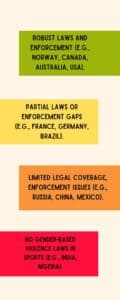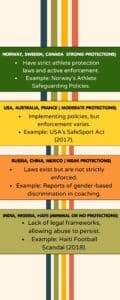
Fighting Violence Against Women in Sports
# Tackling Violence Against Women and Girls in Sport
Introduction: Breaking the Silence on Abuse in Sport
Violence against women and girls remains one of the most persistent human rights issues worldwide. In sports, the risk intensifies due to structural power imbalances, inadequate protection mechanisms, and institutional silencing. Female athletes, journalists, and officials often navigate a field fraught with sexual harassment, coercion, economic abuse, and psychological manipulation.
Despite its empowering potential, sport is also a space where gender-based violence thrives. The lack of women in leadership roles, underrepresentation in media, and weak regulatory frameworks exacerbates the risks, allowing perpetrators to act with impunity. Addressing these issues requires comprehensive action from sports organizations, legal bodies, and civil society. Awareness campaigns, survivor advocacy, and concrete policy changes are necessary to shift the culture of silence that surrounds abuse in sports.
The Many Faces of Abuse in Sports
Violence in sport manifests in varied and often overlapping ways. Studies indicate that 1 in 3 women globally experience physical or sexual violence, and sports is no exception. Sexual abuse remains a major concern, with reports showing that 21% of female athletes have experienced sexual abuse in childhood sports settings. Perpetrators often include coaches, teammates, sponsors, and other figures in positions of power.
Beyond sexual abuse, women face psychological and physical violence, from extreme training regimes used as punishment to verbal harassment and intimidation that erodes their mental well-being. Economic abuse is another major concern, with female athletes frequently coerced into exploitative contracts or losing sponsorships for speaking out against abuse. Online harassment has surged, particularly on social media, where 87% of abusive tweets during the Tokyo Olympics targeted female athletes.
In addition, many women face institutional barriers to justice. The fear of speaking out, coupled with the potential of career damage, keeps many survivors silent. Even when complaints are made, sports organizations often prioritize their reputations over the well-being of the victims, leading to cover-ups and lack of accountability.
Understanding the Sports Ecosystem and Power Structures
The sports industry is hierarchical, with decision-making often concentrated in male-dominated leadership structures. International sports federations, national governing bodies, clubs, and media all influence policies and cultural norms.
One of the biggest barriers to addressing violence is a lack of clear governance and accountability. While organizations such as FIFA, the IOC, and national Olympic committees have policies addressing gender-based violence, enforcement remains inconsistent. Survivors often struggle to report abuse due to inadequate mechanisms, fear of retaliation, or institutional cover-ups.
The underrepresentation of women in coaching, sports management, and media further reinforces the silence around abuse. Women hold only 14% of executive positions in international sports federations, limiting their ability to influence policies. A lack of gender-inclusive policies in coaching also leaves female athletes without adequate support, increasing their vulnerability to exploitation.
The sponsorship and financial structures in sports also play a role in perpetuating violence. Women in sports often face unequal access to sponsorship deals, lower salaries, and fewer endorsement opportunities. This economic disparity means that many female athletes are financially dependent on their teams and managers, making it difficult to walk away from abusive environments.
High-Profile Cases and Their Impact
Numerous scandals have exposed the systemic failures of sports organizations in preventing and addressing abuse.
The USA Gymnastics sexual abuse scandal involving Larry Nassar revealed decades of institutional neglect that allowed the abuse of over 300 young female athletes, including Olympic champions. The case sparked worldwide discussions on accountability and survivor justice, pushing for reforms in sports governance.
Similarly, in football, the case of Yves Jean-Bart, the former Haitian Football Federation president, highlighted how abuse is often covered up at the highest levels. Despite FIFA’s intervention, reports indicate that systemic abuses persist in many federations worldwide.
In Greece, Sofia Bekatorou’s revelations about sexual abuse in sailing triggered a wave of disclosures across various sports, contributing to the country’s growing #MeToo movement.
Beyond individual cases, these scandals highlight a larger pattern of systemic failure. Many organizations prefer to settle cases quietly rather than address the root causes. In some cases, even when perpetrators are removed, the underlying toxic culture remains unchanged, leaving future athletes at risk.
Legal and Policy Frameworks: Progress and Gaps
While international organizations have made incremental progress, there are still significant gaps in legal protections and enforcement.
FIFA has introduced a human rights policy that includes gender-based violence prevention measures. The IOC’s Gender Equality Review Project aims to increase female representation in sports governance, while SafeSport programs in the USA and Australia focus on education and prevention.
However, many countries lack comprehensive legislation to address gender-based violence in sports. Even where laws exist, implementation is weak, and cases are often dismissed or delayed due to lack of evidence or institutional reluctance to prosecute.
Long-Term Solutions: Creating a Safer Sporting Environment
To effectively combat violence against women in sports, multi-faceted solutions are needed:
Legal frameworks must be strengthened to ensure that sports organizations are held accountable for addressing abuse. Mandatory safeguarding policies, survivor-centered reporting mechanisms, and whistleblower protections should be standard across all sporting organizations.
There must be a push for cultural change in sports. Athletes, coaches, and organizations must be educated on gender equity, consent, and bystander intervention. Empowering survivors to speak out and ensuring they have access to mental health resources and legal support is also essential.
Social media and sports journalism must be more accountable, ensuring that online harassment and victim-blaming are actively addressed. Major platforms should implement automated monitoring systems to detect and remove abusive content aimed at female athletes.
Final Thoughts: A Call for Institutional and Cultural Change
Violence against women in sports is not just a sports issue—it is a human rights issue. Tackling it requires collective action from governing bodies, media, fans, and athletes themselves.
Progress has been made, but systemic change will only happen when institutions prioritize athlete welfare over reputation. It is time for sports organizations worldwide to take decisive action and create environments where women can participate without fear.


You May Also Like

Toxic Mother Daughter Relationships: Power and Pain
October 21, 2024
The Trophy Of The Fight Is Justice.
October 15, 2024








